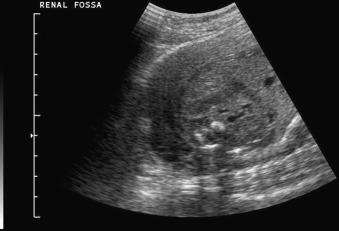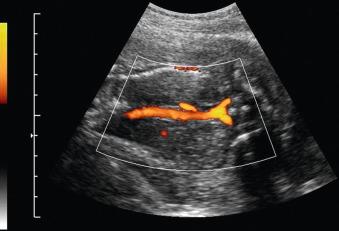Physical Address
304 North Cardinal St.
Dorchester Center, MA 02124
Fraser syndrome is a rare congenital malformation syndrome characterized by cryptophthalmos, syndactyly, and urogenital defects.
Thomas et al. formulated the diagnostic criteria for Fraser syndrome including four major (cryptophthalmos, syndactyly, abnormal genitalia, and affected sibling) and eight minor criteria (congenital malformations of nose, ears, and larynx; cleft lip with or without cleft palate; skeletal symptoms; umbilical hernia; renal agenesis; mental retardation). These authors suggested that the diagnosis be assigned if two major and one minor criteria or one major and four minor criteria are present in a patient. In practice, prenatal diagnosis often relies on detection of some of the more easily detectable minor criteria, such as renal agenesis ( Figs. 128.1 and 128.2 ) and laryngeal atresia, together with a family history. Cryptophthalmos is the most important diagnostic feature of Fraser syndrome and has been described in 90% of affected patients ( Fig. 128.3 ). It consists of a continuous skin covering from the forehead to the cheek with absent palpebral fissures.



The incidence of Fraser syndrome is 0.43 : 100,000 live births and 11.06 : 100,000 stillbirths. The inheritance pattern is autosomal recessive, with an unusual proportion of infants born to consanguineous parents.
Mutations in the FRAS1 and FREM2 genes have been implicated in the etiology of Fraser syndrome. An underlying defect of apoptosis is suggested because several of the anomalies such as fused eyelids, digits, larynx, and vagina result from failure of programmed cell death.
Become a Clinical Tree membership for Full access and enjoy Unlimited articles
If you are a member. Log in here